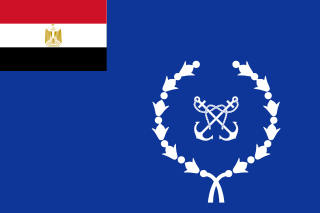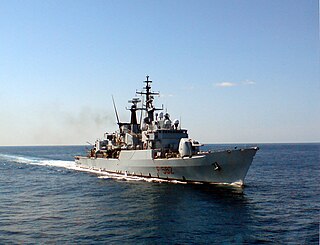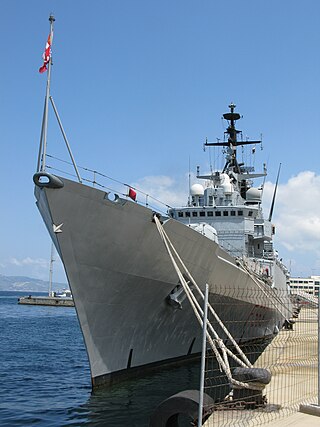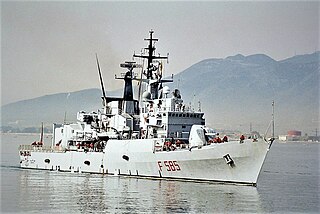
The Sixth Fleet is a numbered fleet of the United States Navy operating as part of United States Naval Forces Europe-Africa. The Sixth Fleet is headquartered at Naval Support Activity Naples, Italy. The officially stated mission of the Sixth Fleet in 2011 is that it "conducts the full range of Maritime Operations and Theater Security Cooperation missions, in concert with coalition, joint, interagency, and other parties, in order to advance security and stability in Europe and Africa." The current commander of the Sixth Fleet is Vice Admiral Jeffrey T. Anderson.

Giuseppe Garibaldi is an Italian aircraft carrier, the first through-deck aviation ship ever built for the Italian Navy, and the first Italian ship built to operate fixed-wing aircraft. Although it is widely recognised as a carrier first and foremost, it is officially designated as an aircraft-carrying cruiser. It is equipped with short take-off and vertical landing (STOVL) aircraft and helicopters. Giuseppe Garibaldi was involved in combat air operations off Somalia, Kosovo, Afghanistan and Libya.

HMS Liverpool was a Type 42 destroyer of the Royal Navy. She was built by Cammell Laird in Birkenhead and launched on 25 September 1980 by Lady Strathcona, wife of Euan Howard, the then Minister of State for Defence. Liverpool was the last Type 42 Batch 2 in service.

The Italian Navy is one of the four branches of Italian Armed Forces and was formed in 1946 from what remained of the Regia Marina after World War II. As of August 2014, the Italian Navy had a strength of 30,923 active personnel, with approximately 184 vessels in service, including minor auxiliary vessels. It is considered a multiregional and a blue-water navy.

USS Nicholas (FFG-47), an Oliver Hazard Perry-class frigate, was the third ship of the United States Navy to be named for Major Samuel Nicholas, the first commanding officer of the United States Marines. A third-generation guided missile frigate of the Oliver Hazard Perry class, she was laid down as Bath Iron Works hull number 388 on 27 September 1982 and launched 23 April 1983. Sponsor at her commissioning there on 10 March 1984 was the same Mrs. Edward B. Tryon who sponsored DD 449 in 1942.

The Libyan Navy is the naval warfare branch of the Libyan Armed Forces. Established in November 1962, Libyan Navy was headed by Admiral Mansour Bader, Chief of Staff of the Libyan Naval Force. Before the First Libyan Civil War, it was a fairly typical small navy with a few missile frigates, corvettes and patrol boats to defend the coastline, but with a very limited self-defence capability.

The Iraqi Naval Forces, or the Iraqi Navy, is the naval warfare service branch of the Armed forces of Iraq. Formed in 1937, initially as the Iraqi Coastal Defense Force, its primary responsibilities was the protection of Iraq's coastline and offshore assets, the official name was changed on 12 January 2005 to Iraqi Naval Forces.

The Lupo class is a class of frigates built by Cantieri Navali Riuniti (CNR) for the Italian Navy. Designed as multipurpose warships with an emphasis on anti-surface warfare (ASuW), they have enjoyed some success in the export market, being acquired by the navies of Peru and Venezuela. A small run of a slightly updated version is known as the Soldati class.

The Krivak class, Soviet designation Project 1135 Burevestnik, are a series of frigates and patrol ships built in the Soviet Union primarily for the Soviet Navy since 1970. Later some sub-branches, like the Nerey (Nereus) were designed for coastal patrol by the KGB Border Troops. Until 1977, the ships in the class were considered to be large anti-submarine warfare vessels.

The Egyptian Navy, also known as the Egyptian Naval Forces, is the maritime branch of the Egyptian Armed Forces. It is the largest navy in the Middle East as well as Africa, and is the twelfth largest navy in the world. The navy protects more than 2,000 kilometers of coastline of the Mediterranean Sea and the Red Sea, defense of approaches to the Suez Canal, and it also supports for army operations. The majority of the modern Egyptian Navy was created with the help of the Soviet Union in the 1960s. The navy received ships in the 1980s from China and Western sources. In 1989, the Egyptian Navy had 18,000 personnel as well as 2,000 personnel in the Coast Guard. The navy received ships from the US in 1990. US shipbuilder Swiftships has built around 30 boats for the Egyptian Navy including mine hunters, survey vessels, and both steel and aluminium patrol boats.

HNLMS De Ruyter is a De Zeven Provinciën-class frigate of the Royal Netherlands Navy. She was laid down in 2000, launched in 2002, and commissioned in 2004, the third ship of her class to enter service. The frigate is named after Dutch admiral Michiel de Ruyter (1607–1676).

Operation Odyssey Dawn was the U.S. code name for the American role in the international military operation in Libya to enforce United Nations Security Council Resolution 1973 during the initial period of 19–31 March 2011, which continued afterwards under NATO command as Operation Unified Protector. The initial operation implemented a no-fly zone that was proposed during the Libyan Civil War to prevent government forces loyal to Muammar Gaddafi from carrying out air attacks on anti-Gaddafi forces. On 19 March 2011, several countries prepared to take immediate military action at a summit in Paris. Operations commenced on the same day with a strike by French fighter jets, then US and UK forces conducting strikes from ships and submarines via 110 Tomahawk cruise missiles and air assets bombing Gaddafi forces near Benghazi. The goal of coalition forces was to impose a no-fly zone for Libyan government forces.

Operation Unified Protector was a NATO operation in 2011 enforcing United Nations Security Council resolutions 1970 and 1973 concerning the Libyan Civil War and adopted on 26 February and 17 March 2011, respectively. These resolutions imposed sanctions on key members of the Gaddafi government and authorized NATO to implement an arms embargo, a no-fly zone and to use all means necessary, short of foreign occupation, to protect Libyan civilians and civilian populated areas.

The European Union Naval Force Mediterranean Operation Irini was launched on 31 March 2020 with the primary mission to enforce the United Nations arms embargo to Libya due to the Second Libyan Civil War. Operation Irini is a European Union military operation under the umbrella of the Common Security and Defense Policy (CSDP). The operation is expected to use aerial, maritime and satellite assets.
The following is the structure of the Italian Navy as of June 2020. It is considered a multiregional and a blue-water navy.

Carlo Bergamini(F 590) is a Carlo Bergamini-class frigate of the Italian Navy. Which in turn were developed by the FREMM multipurpose frigate program.

Artigliere (F-582) was the lead ship of the Soldati-class frigate of the Italian Navy.

Aviere (F-583) was the second ship of the Soldati-class frigate of the Italian Navy.

Bersagliere (F-584) was the fourth ship of the Soldati-class frigate of the Italian Navy.

Garibaldino was a Soldato-class ("Soldier"-class) destroyer of the Italian Regia Marina. Commissioned in 1910, she served in the Italo-Turkish War and World War I. During the latter conflict she sank after a collision in 1918.






















